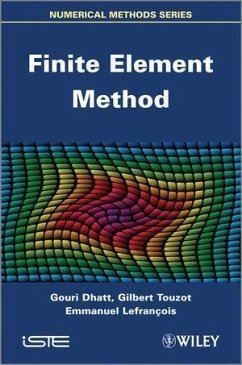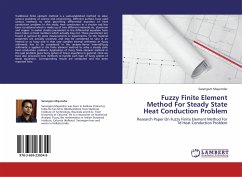- Gebundenes Buch
- Merkliste
- Auf die Merkliste
- Bewerten Bewerten
- Teilen
- Produkt teilen
- Produkterinnerung
- Produkterinnerung
This book provides a comprehensive introduction to the finite element method; in particular, it covers approximation, standard elements, variational formulation, matrix representation of finite element expressions, numerical methods adapted to finite elements and computer implementation and programming based on Matlabã scripts. All the concepts are explained with the use of examples, thus stressing the self-learning of finite elements.
This book offers an in-depth presentation of the finite element method, aimed at engineers, students and researchers in applied sciences. The description of…mehr
Andere Kunden interessierten sich auch für
![Finite Mathematics Finite Mathematics]() Carla C. MorrisFinite Mathematics162,99 €
Carla C. MorrisFinite Mathematics162,99 €![The Finite Element Method The Finite Element Method]() Bofang ZhuThe Finite Element Method187,99 €
Bofang ZhuThe Finite Element Method187,99 €![Finite-Element-Analysis Finite-Element-Analysis]() R. H. GallagherFinite-Element-Analysis49,95 €
R. H. GallagherFinite-Element-Analysis49,95 €![Applied Diffusion Processes from Engineering to Finance Applied Diffusion Processes from Engineering to Finance]() Jacques JanssenApplied Diffusion Processes from Engineering to Finance225,99 €
Jacques JanssenApplied Diffusion Processes from Engineering to Finance225,99 €![The Restricted Burnside Problem The Restricted Burnside Problem]() Michael Vaughan-LeeThe Restricted Burnside Problem86,99 €
Michael Vaughan-LeeThe Restricted Burnside Problem86,99 €![Structure Theorems of Unit Groups Structure Theorems of Unit Groups]() Eric JespersStructure Theorems of Unit Groups22,99 €
Eric JespersStructure Theorems of Unit Groups22,99 €![Fuzzy Finite Element Method For Steady State Heat Conduction Problem Fuzzy Finite Element Method For Steady State Heat Conduction Problem]() Sarangam MajumdarFuzzy Finite Element Method For Steady State Heat Conduction Problem33,99 €
Sarangam MajumdarFuzzy Finite Element Method For Steady State Heat Conduction Problem33,99 €-
-
-
This book provides a comprehensive introduction to the finite element method; in particular, it covers approximation, standard elements, variational formulation, matrix representation of finite element expressions, numerical methods adapted to finite elements and computer implementation and programming based on Matlabã scripts. All the concepts are explained with the use of examples, thus stressing the self-learning of finite elements.
This book offers an in-depth presentation of the finite element method, aimed at engineers, students and researchers in applied sciences.
The description of the method is presented in such a way as to be usable in any domain of application. The level of mathematical expertise required is limited to differential and matrix calculus.
The various stages necessary for the implementation of the method are clearly identified, with a chapter given over to each one: approximation, construction of the integral forms, matrix organization, solution of the algebraic systems and architecture of programs. The final chapter lays the foundations for a general program, written in Matlab, which can be used to solve problems that are linear or otherwise, stationary or transient, presented in relation to applications stemming from the domains of structural mechanics, fluid mechanics and heat transfer.
Hinweis: Dieser Artikel kann nur an eine deutsche Lieferadresse ausgeliefert werden.
This book offers an in-depth presentation of the finite element method, aimed at engineers, students and researchers in applied sciences.
The description of the method is presented in such a way as to be usable in any domain of application. The level of mathematical expertise required is limited to differential and matrix calculus.
The various stages necessary for the implementation of the method are clearly identified, with a chapter given over to each one: approximation, construction of the integral forms, matrix organization, solution of the algebraic systems and architecture of programs. The final chapter lays the foundations for a general program, written in Matlab, which can be used to solve problems that are linear or otherwise, stationary or transient, presented in relation to applications stemming from the domains of structural mechanics, fluid mechanics and heat transfer.
Hinweis: Dieser Artikel kann nur an eine deutsche Lieferadresse ausgeliefert werden.
Produktdetails
- Produktdetails
- ISTE .
- Verlag: Wiley & Sons
- 1. Auflage
- Seitenzahl: 624
- Erscheinungstermin: 30. November 2012
- Englisch
- Abmessung: 238mm x 161mm x 40mm
- Gewicht: 590g
- ISBN-13: 9781848213685
- ISBN-10: 1848213689
- Artikelnr.: 35967641
- Herstellerkennzeichnung
- Libri GmbH
- Europaallee 1
- 36244 Bad Hersfeld
- gpsr@libri.de
- ISTE .
- Verlag: Wiley & Sons
- 1. Auflage
- Seitenzahl: 624
- Erscheinungstermin: 30. November 2012
- Englisch
- Abmessung: 238mm x 161mm x 40mm
- Gewicht: 590g
- ISBN-13: 9781848213685
- ISBN-10: 1848213689
- Artikelnr.: 35967641
- Herstellerkennzeichnung
- Libri GmbH
- Europaallee 1
- 36244 Bad Hersfeld
- gpsr@libri.de
Gouri Dhatt obtained his D.SC in 1968 from Laval University on Numerical Modelling. Since 1968 he has been working as Professor of Engineering at Laval University Quebec, University of Technology Compiegne and INSA Rouen. He is co-author of various books on Finite Elements and its applications. Emmanuel Lefrançois is currently an associate professor at the University of Technology of Compiègne (UTC). Areas of expertise concern computer sciences for multiphysics applications and essentially for fluid-structure interactions. Teaching areas concern the computer sciences (finite element) and fluid mechanics. Gilbert Touzot is Emeritus Professor. Since 1967 he has been working in computational méchanics at Université du Québec, Université de Compiègne and National Institute of Applied Sciences Rouen. He is presently président of the french national digital University of Technology - UNIT.
Introduction 1 0.1 The finite element method 1 0.1.1 General remarks 1 0.1.2 Historical evolution of the method 2 0.1.3 State of the art 3 0.2 Object and organization of the book 3 0.2.1 Teaching the finite element method 3 0.2.2 Objectives of the book 4 0.2.3 Organization of the book 4 0.3 Numerical modeling approach 6 0.3.1 General aspects 6 0.3.2 Physical model 7 0.3.3 Mathematical model 9 0.3.4 Numerical model 10 0.3.5 Computer model 13 Bibliography 16 Conference proceedings 17 Monographs 18 Periodicals 19 Chapter 1. Approximations with finite elements 21 1.0 Introduction 21 1.1 General remarks 21 1.1.1 Nodal approximation 21 1.1.2 Approximations with finite elements 28 1.2 Geometrical definition of the elements 33 1.2.1 Geometrical nodes 33 1.2.2 Rules for the partition of a domain into elements 33 1.2.3 Shapes of some classical elements 35 1.2.4 Reference elements 37 1.2.5 Shapes of some classical reference elements 41 1.2.6 Node and element definition tables 44 1.3 Approximation based on a reference element 45 1.3.1 Expression of the approximate function u(x) 45 1.3.2 Properties of approximate function u(x) 49 1.4 Construction of functions N (
) and N (
) 54 1.4.1 General method of construction 54 1.4.2 Algebraic properties of functions N and N 59 1.5 Transformation of derivation operators 61 1.5.1 General remarks 61 1.5.2 First derivatives 62 1.5.3 Second derivatives 65 1.5.4 Singularity of the Jacobian matrix 68 1.6 Computation of functions N, their derivatives and the Jacobian matrix 72 1.6.1 General remarks 72 1.6.2 Explicit forms for N 73 1.7 Approximation errors on an element 75 1.7.1 Notions of approximation errors 75 1.7.2 Error evaluation technique 80 1.7.3 Improving the precision of approximation 83 1.8 Example of application: rainfall problem 89 Bibliography 95 Chapter 2. Various types of elements 97 2.0 Introduction 97 2.1 List of the elements presented in this chapter 97 2.2 One-dimensional elements 99 2.2.1 Linear element (two nodes, C0) 99 2.2.2 High-precision Lagrangian elements: (continuity C0) 101 2.2.3 High-precision Hermite elements 105 2.2.4 General elements 109 2.3 Triangular elements (two dimensions) 111 2.3.1 Systems of coordinates 111 2.3.2 Linear element (triangle, three nodes, C0) 113 2.3.3 High-precision Lagrangian elements (continuity C0) 115 2.3.4 High-precision Hermite elements 123 2.4 Quadrilateral elements (two dimensions) 127 2.4.1 Systems of coordinates 127 2.4.2 Bilinear element (quadrilateral, 4 nodes, C0) 128 2.4.3 High-precision Lagrangian elements 129 2.4.4 High-precision Hermite element 134 2.5 Tetrahedral elements (three dimensions) 137 2.5.1 Systems of coordinates 137 2.5.2 Linear element (tetrahedron, four nodes, C0) 139 2.5.3 High-precision Lagrangian elements (continuity C0) 140 2.5.4 High-precision Hermite elements 142 2.6 Hexahedric elements (three dimensions) 143 2.6.1 Trilinear element (hexahedron, eight nodes, C0) 143 2.6.2 High-precision Lagrangian elements (continuity C0) 144 2.6.3 High-precision Hermite elements 150 2.7 Prismatic elements (three dimensions) 150 2.7.1 Element with six nodes (prism, six nodes, C0) 150 2.7.2 Element with 15 nodes (prism, 15 nodes, C0) 151 2.8 Pyramidal element (three dimensions) 152 2.8.1 Element with five nodes 152 2.9 Other elements 153 2.9.1 Approximation of vectorial values 153 2.9.2 Modifications of the elements 155 2.9.3 Elements with a variable number of nodes 156 2.9.4 Superparametric elements 158 2.9.5 Infinite elements 158 Bibliography 160 Chapter 3. Integral formulation 161 3.0 Introduction 161 3.1 Classification of physical systems 163 3.1.1 Discrete and continuous systems 163 3.1.2 Equilibrium, eigenvalue and propagation problems 164 3.2 Weighted residual method 172 3.2.1 Residuals 172 3.2.2 Integral forms 173 3.3 Integral transformations 174 3.3.1 Integration by parts 174 3.3.2 Weak integral form 177 3.3.3 Construction of additional integral forms 179 3.4 Functionals 182 3.4.1 First variation 182 3.4.2 Functional associated with an integral form 183 3.4.3 Stationarity principle 187 3.4.4 Lagrange multipliers and additional functionals 188 3.5 Discretization of integral forms 194 3.5.1 Discretization of W 194 3.5.2 Approximation of the functions u 197 3.5.3 Choice of the weighting functions
198 3.5.4 Discretization of a functional (Ritz method) 205 3.5.5 Properties of the systems of equations 208 3.6 List of PDEs and weak expressions 209 3.6.1 Scalar field problems 210 3.6.2 Solid mechanics 213 3.6.3 Fluid mechanics 217 Bibliography 229 Chapter 4. Matrix presentation of the finite element method 231 4.0 Introduction 231 4.1 The finite element method 231 4.1.1 Finite element approach 231 4.1.2 Conditions for convergence of the solution 243 4.1.3 Patch test 256 4.2 Discretized elementary integral forms We 264 4.2.1 Matrix expression of We 264 4.2.2 Case of a nonlinear operator L 267 4.2.3 Integral form We on the reference element 269 4.2.4 A few classic forms of We and of elementary matrices 274 4.3 Techniques for calculating elementary matrices 274 4.3.1 Explicit calculation for a triangular element (Poisson's equation) 274 4.3.2 Explicit calculation for a quadrangular element (Poisson's equation) 279 4.3.3 Organization of the calculation of the elementary matrices by numerical integration 280 4.3.4 Calculation of the elementary matrices: linear problems 282 4.4 Assembly of the global discretized form W 297 4.4.1 Assembly by expansion of the elementary matrices 298 4.4.2 Assembly in structural mechanics 303 4.5 Technique of assembly 305 4.5.1 Stages of assembly 305 4.5.2 Rules of assembly 305 4.5.3 Example of a subprogram for assembly 307 4.5.4 Construction of the localization table LOCE 308 4.6 Properties of global matrices 310 4.6.1 Band structure 310 4.6.2 Symmetry 314 4.6.3 Storage methods 314 4.7 Global system of equations 318 4.7.1 Expression of the system of equations 318 4.7.2 Introduction of the boundary conditions 318 4.7.3 Reactions 321 4.7.4 Transformation of variables 321 4.7.5 Linear relations between variables 323 4.8 Example of application: Poisson's equation 324 4.9 Some concepts about convergence, stability and error calculation 329 4.9.1 Notations 329 4.9.2 Properties of the exact solution 330 4.9.3 Properties of the solution obtained by the finite element method 331 4.9.4 Stability and locking 334 4.9.5 One-dimensional exact finite elements 337 Bibliography 343 Chapter 5. Numerical Methods 345 5.0 Introduction 345 5.1 Numerical integration 346 5.1.1 Introduction 346 5.1.2 One-dimensional numerical integration 348 5.1.3 Two-dimensional numerical integration 360 5.1.4 Numerical integration in three dimensions 368 5.1.5 Precision of integration 372 5.1.6 Choice of number of integration points 375 5.1.7 Numerical integration codes 379 5.2 Solving systems of linear equations 384 5.2.1 Introduction 384 5.2.2 Gaussian elimination method 385 5.2.3 Decomposition 391 5.2.4 Adaptation of algorithm (5.44) to the case of a matrix stored by the skyline method 399 5.3 Solution of nonlinear systems 404 5.3.1 Introduction 404 5.3.2 Substitution method 407 5.3.3 Newton-Raphson method 411 5.3.4 Incremental (or step-by-step) method 420 5.3.5 Changing of independent variables 421 5.3.6 Solution strategy 424 5.3.7 Convergence of an iterative method 426 5.4 Resolution of unsteady systems 429 5.4.1 Introduction 429 5.4.2 Direct integration methods for first-order systems 431 5.4.3 Modal superposition method for first-order systems 463 5.4.4 Methods for direct integration of second-order systems 466 5.4.5 Modal superposition method for second-order systems 476 5.5 Methods for calculating the eigenvalues and eigenvectors 480 5.5.1 Introduction 480 5.5.2 Recap of some properties of eigenvalue problems 481 5.5.3 Methods for calculating the eigenvalues 488 Bibliography 502 Chapter 6. Programming technique 505 6.0 Introduction 505 6.1 Functional blocks of a finite element program 506 6.2 Description of a typical problem 507 6.3 General programs 508 6.3.1 Possibilities of general programs 508 6.3.2 Modularity 511 6.4 Description of the finite element code 512 6.4.1 Introduction 512 6.4.2 General organization 513 6.4.3 Description of tables and variables 517 6.5 Library of elementary finite element method programs 521 6.5.1 Functional blocks 521 6.5.2 List of thermal elements 530 6.5.3 List of elastic elements 538 6.5.4 List of elements for fluid mechanics 545 6.6 Examples of application 549 6.6.1 Heat transfer problems 550 6.6.2 Planar elastic problems 558 6.6.3 Fluid flow problems 566 Appendix. Sparse solver 577 7.0 Introduction 577 7.1 Methodology of the sparse solver 578 7.1.1 Assembly of matrices in sparse form: row-by-row format 579 7.1.2 Permutation using the "minimum degree" algorithm 584 7.1.3 Modified column-column storage format 587 7.1.4 Symbolic factorization 589 7.1.5 Numerical factorization 590 7.1.6 Solution of the system by descent/ascent 592 7.2 Numerical examples 593 Bibliography 595 Index 597
) and N (
) 54 1.4.1 General method of construction 54 1.4.2 Algebraic properties of functions N and N 59 1.5 Transformation of derivation operators 61 1.5.1 General remarks 61 1.5.2 First derivatives 62 1.5.3 Second derivatives 65 1.5.4 Singularity of the Jacobian matrix 68 1.6 Computation of functions N, their derivatives and the Jacobian matrix 72 1.6.1 General remarks 72 1.6.2 Explicit forms for N 73 1.7 Approximation errors on an element 75 1.7.1 Notions of approximation errors 75 1.7.2 Error evaluation technique 80 1.7.3 Improving the precision of approximation 83 1.8 Example of application: rainfall problem 89 Bibliography 95 Chapter 2. Various types of elements 97 2.0 Introduction 97 2.1 List of the elements presented in this chapter 97 2.2 One-dimensional elements 99 2.2.1 Linear element (two nodes, C0) 99 2.2.2 High-precision Lagrangian elements: (continuity C0) 101 2.2.3 High-precision Hermite elements 105 2.2.4 General elements 109 2.3 Triangular elements (two dimensions) 111 2.3.1 Systems of coordinates 111 2.3.2 Linear element (triangle, three nodes, C0) 113 2.3.3 High-precision Lagrangian elements (continuity C0) 115 2.3.4 High-precision Hermite elements 123 2.4 Quadrilateral elements (two dimensions) 127 2.4.1 Systems of coordinates 127 2.4.2 Bilinear element (quadrilateral, 4 nodes, C0) 128 2.4.3 High-precision Lagrangian elements 129 2.4.4 High-precision Hermite element 134 2.5 Tetrahedral elements (three dimensions) 137 2.5.1 Systems of coordinates 137 2.5.2 Linear element (tetrahedron, four nodes, C0) 139 2.5.3 High-precision Lagrangian elements (continuity C0) 140 2.5.4 High-precision Hermite elements 142 2.6 Hexahedric elements (three dimensions) 143 2.6.1 Trilinear element (hexahedron, eight nodes, C0) 143 2.6.2 High-precision Lagrangian elements (continuity C0) 144 2.6.3 High-precision Hermite elements 150 2.7 Prismatic elements (three dimensions) 150 2.7.1 Element with six nodes (prism, six nodes, C0) 150 2.7.2 Element with 15 nodes (prism, 15 nodes, C0) 151 2.8 Pyramidal element (three dimensions) 152 2.8.1 Element with five nodes 152 2.9 Other elements 153 2.9.1 Approximation of vectorial values 153 2.9.2 Modifications of the elements 155 2.9.3 Elements with a variable number of nodes 156 2.9.4 Superparametric elements 158 2.9.5 Infinite elements 158 Bibliography 160 Chapter 3. Integral formulation 161 3.0 Introduction 161 3.1 Classification of physical systems 163 3.1.1 Discrete and continuous systems 163 3.1.2 Equilibrium, eigenvalue and propagation problems 164 3.2 Weighted residual method 172 3.2.1 Residuals 172 3.2.2 Integral forms 173 3.3 Integral transformations 174 3.3.1 Integration by parts 174 3.3.2 Weak integral form 177 3.3.3 Construction of additional integral forms 179 3.4 Functionals 182 3.4.1 First variation 182 3.4.2 Functional associated with an integral form 183 3.4.3 Stationarity principle 187 3.4.4 Lagrange multipliers and additional functionals 188 3.5 Discretization of integral forms 194 3.5.1 Discretization of W 194 3.5.2 Approximation of the functions u 197 3.5.3 Choice of the weighting functions
198 3.5.4 Discretization of a functional (Ritz method) 205 3.5.5 Properties of the systems of equations 208 3.6 List of PDEs and weak expressions 209 3.6.1 Scalar field problems 210 3.6.2 Solid mechanics 213 3.6.3 Fluid mechanics 217 Bibliography 229 Chapter 4. Matrix presentation of the finite element method 231 4.0 Introduction 231 4.1 The finite element method 231 4.1.1 Finite element approach 231 4.1.2 Conditions for convergence of the solution 243 4.1.3 Patch test 256 4.2 Discretized elementary integral forms We 264 4.2.1 Matrix expression of We 264 4.2.2 Case of a nonlinear operator L 267 4.2.3 Integral form We on the reference element 269 4.2.4 A few classic forms of We and of elementary matrices 274 4.3 Techniques for calculating elementary matrices 274 4.3.1 Explicit calculation for a triangular element (Poisson's equation) 274 4.3.2 Explicit calculation for a quadrangular element (Poisson's equation) 279 4.3.3 Organization of the calculation of the elementary matrices by numerical integration 280 4.3.4 Calculation of the elementary matrices: linear problems 282 4.4 Assembly of the global discretized form W 297 4.4.1 Assembly by expansion of the elementary matrices 298 4.4.2 Assembly in structural mechanics 303 4.5 Technique of assembly 305 4.5.1 Stages of assembly 305 4.5.2 Rules of assembly 305 4.5.3 Example of a subprogram for assembly 307 4.5.4 Construction of the localization table LOCE 308 4.6 Properties of global matrices 310 4.6.1 Band structure 310 4.6.2 Symmetry 314 4.6.3 Storage methods 314 4.7 Global system of equations 318 4.7.1 Expression of the system of equations 318 4.7.2 Introduction of the boundary conditions 318 4.7.3 Reactions 321 4.7.4 Transformation of variables 321 4.7.5 Linear relations between variables 323 4.8 Example of application: Poisson's equation 324 4.9 Some concepts about convergence, stability and error calculation 329 4.9.1 Notations 329 4.9.2 Properties of the exact solution 330 4.9.3 Properties of the solution obtained by the finite element method 331 4.9.4 Stability and locking 334 4.9.5 One-dimensional exact finite elements 337 Bibliography 343 Chapter 5. Numerical Methods 345 5.0 Introduction 345 5.1 Numerical integration 346 5.1.1 Introduction 346 5.1.2 One-dimensional numerical integration 348 5.1.3 Two-dimensional numerical integration 360 5.1.4 Numerical integration in three dimensions 368 5.1.5 Precision of integration 372 5.1.6 Choice of number of integration points 375 5.1.7 Numerical integration codes 379 5.2 Solving systems of linear equations 384 5.2.1 Introduction 384 5.2.2 Gaussian elimination method 385 5.2.3 Decomposition 391 5.2.4 Adaptation of algorithm (5.44) to the case of a matrix stored by the skyline method 399 5.3 Solution of nonlinear systems 404 5.3.1 Introduction 404 5.3.2 Substitution method 407 5.3.3 Newton-Raphson method 411 5.3.4 Incremental (or step-by-step) method 420 5.3.5 Changing of independent variables 421 5.3.6 Solution strategy 424 5.3.7 Convergence of an iterative method 426 5.4 Resolution of unsteady systems 429 5.4.1 Introduction 429 5.4.2 Direct integration methods for first-order systems 431 5.4.3 Modal superposition method for first-order systems 463 5.4.4 Methods for direct integration of second-order systems 466 5.4.5 Modal superposition method for second-order systems 476 5.5 Methods for calculating the eigenvalues and eigenvectors 480 5.5.1 Introduction 480 5.5.2 Recap of some properties of eigenvalue problems 481 5.5.3 Methods for calculating the eigenvalues 488 Bibliography 502 Chapter 6. Programming technique 505 6.0 Introduction 505 6.1 Functional blocks of a finite element program 506 6.2 Description of a typical problem 507 6.3 General programs 508 6.3.1 Possibilities of general programs 508 6.3.2 Modularity 511 6.4 Description of the finite element code 512 6.4.1 Introduction 512 6.4.2 General organization 513 6.4.3 Description of tables and variables 517 6.5 Library of elementary finite element method programs 521 6.5.1 Functional blocks 521 6.5.2 List of thermal elements 530 6.5.3 List of elastic elements 538 6.5.4 List of elements for fluid mechanics 545 6.6 Examples of application 549 6.6.1 Heat transfer problems 550 6.6.2 Planar elastic problems 558 6.6.3 Fluid flow problems 566 Appendix. Sparse solver 577 7.0 Introduction 577 7.1 Methodology of the sparse solver 578 7.1.1 Assembly of matrices in sparse form: row-by-row format 579 7.1.2 Permutation using the "minimum degree" algorithm 584 7.1.3 Modified column-column storage format 587 7.1.4 Symbolic factorization 589 7.1.5 Numerical factorization 590 7.1.6 Solution of the system by descent/ascent 592 7.2 Numerical examples 593 Bibliography 595 Index 597
Introduction 1 0.1 The finite element method 1 0.1.1 General remarks 1 0.1.2 Historical evolution of the method 2 0.1.3 State of the art 3 0.2 Object and organization of the book 3 0.2.1 Teaching the finite element method 3 0.2.2 Objectives of the book 4 0.2.3 Organization of the book 4 0.3 Numerical modeling approach 6 0.3.1 General aspects 6 0.3.2 Physical model 7 0.3.3 Mathematical model 9 0.3.4 Numerical model 10 0.3.5 Computer model 13 Bibliography 16 Conference proceedings 17 Monographs 18 Periodicals 19 Chapter 1. Approximations with finite elements 21 1.0 Introduction 21 1.1 General remarks 21 1.1.1 Nodal approximation 21 1.1.2 Approximations with finite elements 28 1.2 Geometrical definition of the elements 33 1.2.1 Geometrical nodes 33 1.2.2 Rules for the partition of a domain into elements 33 1.2.3 Shapes of some classical elements 35 1.2.4 Reference elements 37 1.2.5 Shapes of some classical reference elements 41 1.2.6 Node and element definition tables 44 1.3 Approximation based on a reference element 45 1.3.1 Expression of the approximate function u(x) 45 1.3.2 Properties of approximate function u(x) 49 1.4 Construction of functions N (
) and N (
) 54 1.4.1 General method of construction 54 1.4.2 Algebraic properties of functions N and N 59 1.5 Transformation of derivation operators 61 1.5.1 General remarks 61 1.5.2 First derivatives 62 1.5.3 Second derivatives 65 1.5.4 Singularity of the Jacobian matrix 68 1.6 Computation of functions N, their derivatives and the Jacobian matrix 72 1.6.1 General remarks 72 1.6.2 Explicit forms for N 73 1.7 Approximation errors on an element 75 1.7.1 Notions of approximation errors 75 1.7.2 Error evaluation technique 80 1.7.3 Improving the precision of approximation 83 1.8 Example of application: rainfall problem 89 Bibliography 95 Chapter 2. Various types of elements 97 2.0 Introduction 97 2.1 List of the elements presented in this chapter 97 2.2 One-dimensional elements 99 2.2.1 Linear element (two nodes, C0) 99 2.2.2 High-precision Lagrangian elements: (continuity C0) 101 2.2.3 High-precision Hermite elements 105 2.2.4 General elements 109 2.3 Triangular elements (two dimensions) 111 2.3.1 Systems of coordinates 111 2.3.2 Linear element (triangle, three nodes, C0) 113 2.3.3 High-precision Lagrangian elements (continuity C0) 115 2.3.4 High-precision Hermite elements 123 2.4 Quadrilateral elements (two dimensions) 127 2.4.1 Systems of coordinates 127 2.4.2 Bilinear element (quadrilateral, 4 nodes, C0) 128 2.4.3 High-precision Lagrangian elements 129 2.4.4 High-precision Hermite element 134 2.5 Tetrahedral elements (three dimensions) 137 2.5.1 Systems of coordinates 137 2.5.2 Linear element (tetrahedron, four nodes, C0) 139 2.5.3 High-precision Lagrangian elements (continuity C0) 140 2.5.4 High-precision Hermite elements 142 2.6 Hexahedric elements (three dimensions) 143 2.6.1 Trilinear element (hexahedron, eight nodes, C0) 143 2.6.2 High-precision Lagrangian elements (continuity C0) 144 2.6.3 High-precision Hermite elements 150 2.7 Prismatic elements (three dimensions) 150 2.7.1 Element with six nodes (prism, six nodes, C0) 150 2.7.2 Element with 15 nodes (prism, 15 nodes, C0) 151 2.8 Pyramidal element (three dimensions) 152 2.8.1 Element with five nodes 152 2.9 Other elements 153 2.9.1 Approximation of vectorial values 153 2.9.2 Modifications of the elements 155 2.9.3 Elements with a variable number of nodes 156 2.9.4 Superparametric elements 158 2.9.5 Infinite elements 158 Bibliography 160 Chapter 3. Integral formulation 161 3.0 Introduction 161 3.1 Classification of physical systems 163 3.1.1 Discrete and continuous systems 163 3.1.2 Equilibrium, eigenvalue and propagation problems 164 3.2 Weighted residual method 172 3.2.1 Residuals 172 3.2.2 Integral forms 173 3.3 Integral transformations 174 3.3.1 Integration by parts 174 3.3.2 Weak integral form 177 3.3.3 Construction of additional integral forms 179 3.4 Functionals 182 3.4.1 First variation 182 3.4.2 Functional associated with an integral form 183 3.4.3 Stationarity principle 187 3.4.4 Lagrange multipliers and additional functionals 188 3.5 Discretization of integral forms 194 3.5.1 Discretization of W 194 3.5.2 Approximation of the functions u 197 3.5.3 Choice of the weighting functions
198 3.5.4 Discretization of a functional (Ritz method) 205 3.5.5 Properties of the systems of equations 208 3.6 List of PDEs and weak expressions 209 3.6.1 Scalar field problems 210 3.6.2 Solid mechanics 213 3.6.3 Fluid mechanics 217 Bibliography 229 Chapter 4. Matrix presentation of the finite element method 231 4.0 Introduction 231 4.1 The finite element method 231 4.1.1 Finite element approach 231 4.1.2 Conditions for convergence of the solution 243 4.1.3 Patch test 256 4.2 Discretized elementary integral forms We 264 4.2.1 Matrix expression of We 264 4.2.2 Case of a nonlinear operator L 267 4.2.3 Integral form We on the reference element 269 4.2.4 A few classic forms of We and of elementary matrices 274 4.3 Techniques for calculating elementary matrices 274 4.3.1 Explicit calculation for a triangular element (Poisson's equation) 274 4.3.2 Explicit calculation for a quadrangular element (Poisson's equation) 279 4.3.3 Organization of the calculation of the elementary matrices by numerical integration 280 4.3.4 Calculation of the elementary matrices: linear problems 282 4.4 Assembly of the global discretized form W 297 4.4.1 Assembly by expansion of the elementary matrices 298 4.4.2 Assembly in structural mechanics 303 4.5 Technique of assembly 305 4.5.1 Stages of assembly 305 4.5.2 Rules of assembly 305 4.5.3 Example of a subprogram for assembly 307 4.5.4 Construction of the localization table LOCE 308 4.6 Properties of global matrices 310 4.6.1 Band structure 310 4.6.2 Symmetry 314 4.6.3 Storage methods 314 4.7 Global system of equations 318 4.7.1 Expression of the system of equations 318 4.7.2 Introduction of the boundary conditions 318 4.7.3 Reactions 321 4.7.4 Transformation of variables 321 4.7.5 Linear relations between variables 323 4.8 Example of application: Poisson's equation 324 4.9 Some concepts about convergence, stability and error calculation 329 4.9.1 Notations 329 4.9.2 Properties of the exact solution 330 4.9.3 Properties of the solution obtained by the finite element method 331 4.9.4 Stability and locking 334 4.9.5 One-dimensional exact finite elements 337 Bibliography 343 Chapter 5. Numerical Methods 345 5.0 Introduction 345 5.1 Numerical integration 346 5.1.1 Introduction 346 5.1.2 One-dimensional numerical integration 348 5.1.3 Two-dimensional numerical integration 360 5.1.4 Numerical integration in three dimensions 368 5.1.5 Precision of integration 372 5.1.6 Choice of number of integration points 375 5.1.7 Numerical integration codes 379 5.2 Solving systems of linear equations 384 5.2.1 Introduction 384 5.2.2 Gaussian elimination method 385 5.2.3 Decomposition 391 5.2.4 Adaptation of algorithm (5.44) to the case of a matrix stored by the skyline method 399 5.3 Solution of nonlinear systems 404 5.3.1 Introduction 404 5.3.2 Substitution method 407 5.3.3 Newton-Raphson method 411 5.3.4 Incremental (or step-by-step) method 420 5.3.5 Changing of independent variables 421 5.3.6 Solution strategy 424 5.3.7 Convergence of an iterative method 426 5.4 Resolution of unsteady systems 429 5.4.1 Introduction 429 5.4.2 Direct integration methods for first-order systems 431 5.4.3 Modal superposition method for first-order systems 463 5.4.4 Methods for direct integration of second-order systems 466 5.4.5 Modal superposition method for second-order systems 476 5.5 Methods for calculating the eigenvalues and eigenvectors 480 5.5.1 Introduction 480 5.5.2 Recap of some properties of eigenvalue problems 481 5.5.3 Methods for calculating the eigenvalues 488 Bibliography 502 Chapter 6. Programming technique 505 6.0 Introduction 505 6.1 Functional blocks of a finite element program 506 6.2 Description of a typical problem 507 6.3 General programs 508 6.3.1 Possibilities of general programs 508 6.3.2 Modularity 511 6.4 Description of the finite element code 512 6.4.1 Introduction 512 6.4.2 General organization 513 6.4.3 Description of tables and variables 517 6.5 Library of elementary finite element method programs 521 6.5.1 Functional blocks 521 6.5.2 List of thermal elements 530 6.5.3 List of elastic elements 538 6.5.4 List of elements for fluid mechanics 545 6.6 Examples of application 549 6.6.1 Heat transfer problems 550 6.6.2 Planar elastic problems 558 6.6.3 Fluid flow problems 566 Appendix. Sparse solver 577 7.0 Introduction 577 7.1 Methodology of the sparse solver 578 7.1.1 Assembly of matrices in sparse form: row-by-row format 579 7.1.2 Permutation using the "minimum degree" algorithm 584 7.1.3 Modified column-column storage format 587 7.1.4 Symbolic factorization 589 7.1.5 Numerical factorization 590 7.1.6 Solution of the system by descent/ascent 592 7.2 Numerical examples 593 Bibliography 595 Index 597
) and N (
) 54 1.4.1 General method of construction 54 1.4.2 Algebraic properties of functions N and N 59 1.5 Transformation of derivation operators 61 1.5.1 General remarks 61 1.5.2 First derivatives 62 1.5.3 Second derivatives 65 1.5.4 Singularity of the Jacobian matrix 68 1.6 Computation of functions N, their derivatives and the Jacobian matrix 72 1.6.1 General remarks 72 1.6.2 Explicit forms for N 73 1.7 Approximation errors on an element 75 1.7.1 Notions of approximation errors 75 1.7.2 Error evaluation technique 80 1.7.3 Improving the precision of approximation 83 1.8 Example of application: rainfall problem 89 Bibliography 95 Chapter 2. Various types of elements 97 2.0 Introduction 97 2.1 List of the elements presented in this chapter 97 2.2 One-dimensional elements 99 2.2.1 Linear element (two nodes, C0) 99 2.2.2 High-precision Lagrangian elements: (continuity C0) 101 2.2.3 High-precision Hermite elements 105 2.2.4 General elements 109 2.3 Triangular elements (two dimensions) 111 2.3.1 Systems of coordinates 111 2.3.2 Linear element (triangle, three nodes, C0) 113 2.3.3 High-precision Lagrangian elements (continuity C0) 115 2.3.4 High-precision Hermite elements 123 2.4 Quadrilateral elements (two dimensions) 127 2.4.1 Systems of coordinates 127 2.4.2 Bilinear element (quadrilateral, 4 nodes, C0) 128 2.4.3 High-precision Lagrangian elements 129 2.4.4 High-precision Hermite element 134 2.5 Tetrahedral elements (three dimensions) 137 2.5.1 Systems of coordinates 137 2.5.2 Linear element (tetrahedron, four nodes, C0) 139 2.5.3 High-precision Lagrangian elements (continuity C0) 140 2.5.4 High-precision Hermite elements 142 2.6 Hexahedric elements (three dimensions) 143 2.6.1 Trilinear element (hexahedron, eight nodes, C0) 143 2.6.2 High-precision Lagrangian elements (continuity C0) 144 2.6.3 High-precision Hermite elements 150 2.7 Prismatic elements (three dimensions) 150 2.7.1 Element with six nodes (prism, six nodes, C0) 150 2.7.2 Element with 15 nodes (prism, 15 nodes, C0) 151 2.8 Pyramidal element (three dimensions) 152 2.8.1 Element with five nodes 152 2.9 Other elements 153 2.9.1 Approximation of vectorial values 153 2.9.2 Modifications of the elements 155 2.9.3 Elements with a variable number of nodes 156 2.9.4 Superparametric elements 158 2.9.5 Infinite elements 158 Bibliography 160 Chapter 3. Integral formulation 161 3.0 Introduction 161 3.1 Classification of physical systems 163 3.1.1 Discrete and continuous systems 163 3.1.2 Equilibrium, eigenvalue and propagation problems 164 3.2 Weighted residual method 172 3.2.1 Residuals 172 3.2.2 Integral forms 173 3.3 Integral transformations 174 3.3.1 Integration by parts 174 3.3.2 Weak integral form 177 3.3.3 Construction of additional integral forms 179 3.4 Functionals 182 3.4.1 First variation 182 3.4.2 Functional associated with an integral form 183 3.4.3 Stationarity principle 187 3.4.4 Lagrange multipliers and additional functionals 188 3.5 Discretization of integral forms 194 3.5.1 Discretization of W 194 3.5.2 Approximation of the functions u 197 3.5.3 Choice of the weighting functions
198 3.5.4 Discretization of a functional (Ritz method) 205 3.5.5 Properties of the systems of equations 208 3.6 List of PDEs and weak expressions 209 3.6.1 Scalar field problems 210 3.6.2 Solid mechanics 213 3.6.3 Fluid mechanics 217 Bibliography 229 Chapter 4. Matrix presentation of the finite element method 231 4.0 Introduction 231 4.1 The finite element method 231 4.1.1 Finite element approach 231 4.1.2 Conditions for convergence of the solution 243 4.1.3 Patch test 256 4.2 Discretized elementary integral forms We 264 4.2.1 Matrix expression of We 264 4.2.2 Case of a nonlinear operator L 267 4.2.3 Integral form We on the reference element 269 4.2.4 A few classic forms of We and of elementary matrices 274 4.3 Techniques for calculating elementary matrices 274 4.3.1 Explicit calculation for a triangular element (Poisson's equation) 274 4.3.2 Explicit calculation for a quadrangular element (Poisson's equation) 279 4.3.3 Organization of the calculation of the elementary matrices by numerical integration 280 4.3.4 Calculation of the elementary matrices: linear problems 282 4.4 Assembly of the global discretized form W 297 4.4.1 Assembly by expansion of the elementary matrices 298 4.4.2 Assembly in structural mechanics 303 4.5 Technique of assembly 305 4.5.1 Stages of assembly 305 4.5.2 Rules of assembly 305 4.5.3 Example of a subprogram for assembly 307 4.5.4 Construction of the localization table LOCE 308 4.6 Properties of global matrices 310 4.6.1 Band structure 310 4.6.2 Symmetry 314 4.6.3 Storage methods 314 4.7 Global system of equations 318 4.7.1 Expression of the system of equations 318 4.7.2 Introduction of the boundary conditions 318 4.7.3 Reactions 321 4.7.4 Transformation of variables 321 4.7.5 Linear relations between variables 323 4.8 Example of application: Poisson's equation 324 4.9 Some concepts about convergence, stability and error calculation 329 4.9.1 Notations 329 4.9.2 Properties of the exact solution 330 4.9.3 Properties of the solution obtained by the finite element method 331 4.9.4 Stability and locking 334 4.9.5 One-dimensional exact finite elements 337 Bibliography 343 Chapter 5. Numerical Methods 345 5.0 Introduction 345 5.1 Numerical integration 346 5.1.1 Introduction 346 5.1.2 One-dimensional numerical integration 348 5.1.3 Two-dimensional numerical integration 360 5.1.4 Numerical integration in three dimensions 368 5.1.5 Precision of integration 372 5.1.6 Choice of number of integration points 375 5.1.7 Numerical integration codes 379 5.2 Solving systems of linear equations 384 5.2.1 Introduction 384 5.2.2 Gaussian elimination method 385 5.2.3 Decomposition 391 5.2.4 Adaptation of algorithm (5.44) to the case of a matrix stored by the skyline method 399 5.3 Solution of nonlinear systems 404 5.3.1 Introduction 404 5.3.2 Substitution method 407 5.3.3 Newton-Raphson method 411 5.3.4 Incremental (or step-by-step) method 420 5.3.5 Changing of independent variables 421 5.3.6 Solution strategy 424 5.3.7 Convergence of an iterative method 426 5.4 Resolution of unsteady systems 429 5.4.1 Introduction 429 5.4.2 Direct integration methods for first-order systems 431 5.4.3 Modal superposition method for first-order systems 463 5.4.4 Methods for direct integration of second-order systems 466 5.4.5 Modal superposition method for second-order systems 476 5.5 Methods for calculating the eigenvalues and eigenvectors 480 5.5.1 Introduction 480 5.5.2 Recap of some properties of eigenvalue problems 481 5.5.3 Methods for calculating the eigenvalues 488 Bibliography 502 Chapter 6. Programming technique 505 6.0 Introduction 505 6.1 Functional blocks of a finite element program 506 6.2 Description of a typical problem 507 6.3 General programs 508 6.3.1 Possibilities of general programs 508 6.3.2 Modularity 511 6.4 Description of the finite element code 512 6.4.1 Introduction 512 6.4.2 General organization 513 6.4.3 Description of tables and variables 517 6.5 Library of elementary finite element method programs 521 6.5.1 Functional blocks 521 6.5.2 List of thermal elements 530 6.5.3 List of elastic elements 538 6.5.4 List of elements for fluid mechanics 545 6.6 Examples of application 549 6.6.1 Heat transfer problems 550 6.6.2 Planar elastic problems 558 6.6.3 Fluid flow problems 566 Appendix. Sparse solver 577 7.0 Introduction 577 7.1 Methodology of the sparse solver 578 7.1.1 Assembly of matrices in sparse form: row-by-row format 579 7.1.2 Permutation using the "minimum degree" algorithm 584 7.1.3 Modified column-column storage format 587 7.1.4 Symbolic factorization 589 7.1.5 Numerical factorization 590 7.1.6 Solution of the system by descent/ascent 592 7.2 Numerical examples 593 Bibliography 595 Index 597








